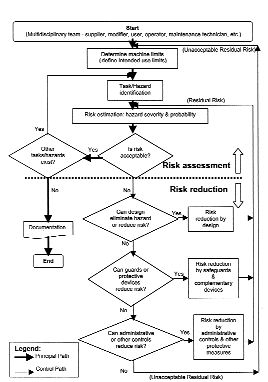
Features
Equipment & Systems
Machine Design Safety Guidelines
Someone once said that the camel is a horse designed by a committee. Nonetheless, though ugly as sin, the camel is very practical and more suited to the desert than the horse. It has hooves like dune ...
August 1, 2002 By Pulp & Paper Canada
 FIGURE 1. Risk Assessment and Risk Reduction Process
FIGURE 1. Risk Assessment and Risk Reduction Process Someone once said that the camel is a horse designed by a committee. Nonetheless, though ugly as sin, the camel is very practical and more suited to the desert than the horse. It has hooves like dune buggy tires and a tank (hump or humps) that holds a 2 week supply of water.
ANSI (American National Standards Institute) got it right when it produced its guide to Risk Assessment and Reduction for Machine Tools, ANSI B11.TR3-2000. This is a guideline, not a standard, which is probably why it has been so well received throughout the world as a practical, realistic risk assessment tool applicable to any machine, system or process, not just machine tools.
The committee attempted to write a document that is similar to the European standards such as EN1050 as well as ISO-14121 but with some new twists:
Task analysis is essential to the hazard identification process. Both tasks and hazards must be identified before initiating risk assessment. [Ex. In the early 1980’s, at a Kenogami mill, a repair technician was troubleshooting a winder gear jam. He fell through a pulp splash guard made of thin aluminum sheeting located under the winder and covering a floor opening over an operating broke beater below. Task analysis might have prevented this fatality.]
The roles of machine supplier, user and any entity involved in modification are defined. This encourages risk assessment and reduction teamwork between all parties/disciplines beginning at the best place, the design stage and continuing throughout the lifecycle of the machine (design, manufacture, shipping, installation, use/operation, tuning, troubleshooting, maintenance and disposal).
Prescriptive safeguards (lockout, 2-hand controls, guards, etc.) cannot be used without first reviewing specific task demands.
Zero risk does not exist. The focus, therefore, is on feasible, appropriate risk reduction (applying the safety hierarchy procedure: eliminate the hazard, engineering controls, warn, train, PPE) as well as the communication of whatever risk remains (residual risk).
RISK ASSESSMENT & RISK REDUCTION:
The Process
The risk assessment and risk reduction process is iterative (Figure 1). The more risks eliminated by the multidisciplinary team at the design and manufacturing stage, the better, but many will not be spotted until the machine is installed at the user’s site.
After a reduction measure is applied, risk estimation must be repeated in case new or additional hazards have been introduced.
References:
Association for Manufacturing Technology(AMT) “Risk Assessment and Risk Reduction – A Guide to Estimate, Evaluate and Reduce Risks Associated with Machine Tools.” ANSI B11.TR3-2000. McLean, VA:AMT, Novenmber 2000.
Andres, Robert N.” Risk Assessment & Reduction: A Look at the Impact of ANSI B11.TR3″, Professional Safety, ASSE, 20-26. ?
John E. Little, B.Eng, CRM, (McGill) is a risk management consultant specializing in safety optimization technologies and software (Solabs Technologies). Contact him at: jelittle@solabs.com
John E. Little is a risk management consultant specializing in safety management optimization technology. He can be contacted at jelittle@solabs.com
Print this page